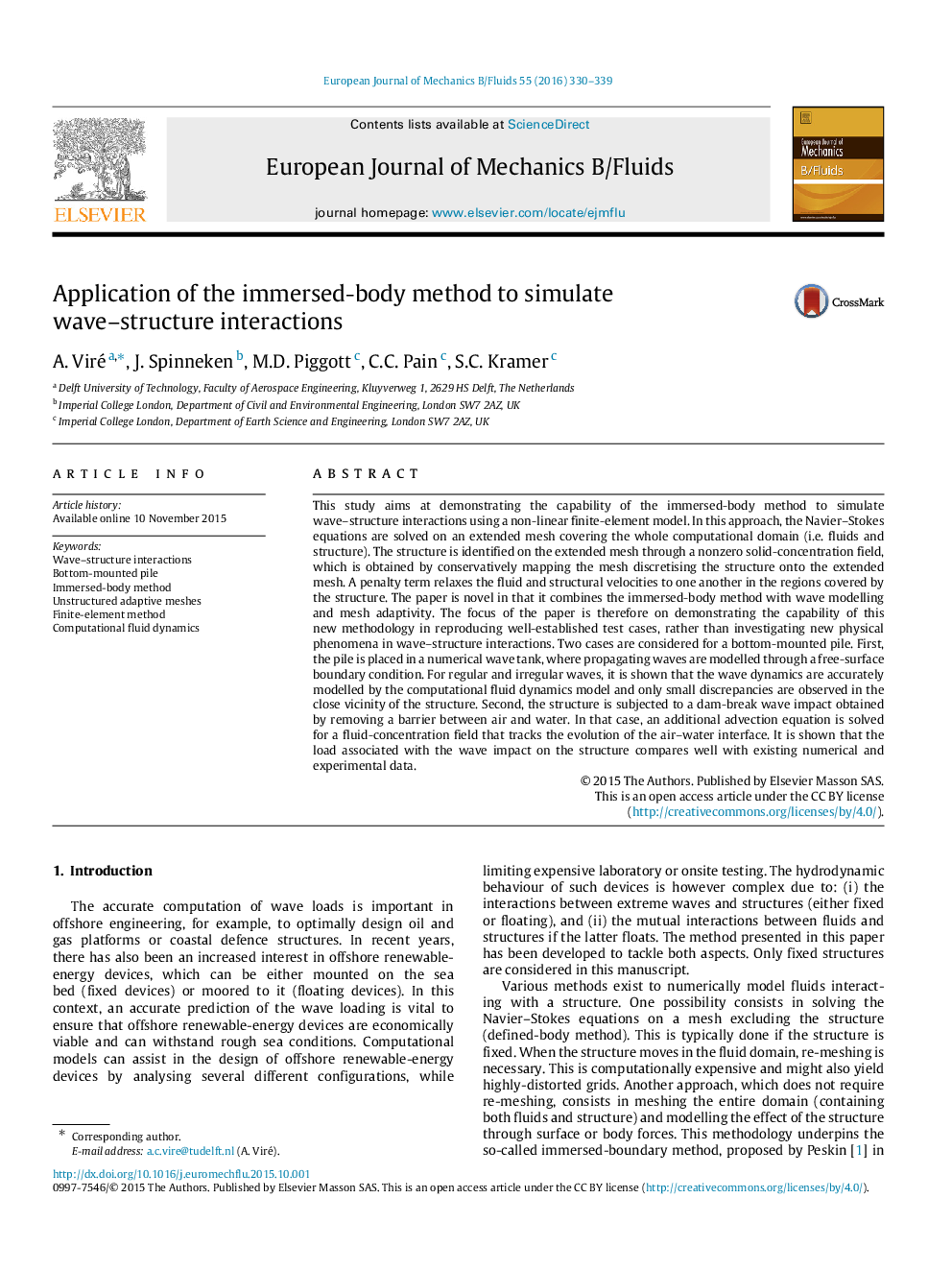| کد مقاله | کد نشریه | سال انتشار | مقاله انگلیسی | نسخه تمام متن |
|---|---|---|---|---|
| 7051271 | 1457269 | 2016 | 10 صفحه PDF | دانلود رایگان |
عنوان انگلیسی مقاله ISI
Application of the immersed-body method to simulate wave-structure interactions
ترجمه فارسی عنوان
استفاده از روش غوطه وری بدن برای شبیه سازی تعاملات ساختار موج
دانلود مقاله + سفارش ترجمه
دانلود مقاله ISI انگلیسی
رایگان برای ایرانیان
کلمات کلیدی
موج تعامل ساختار، شمع پایین نصب شده روش غوطه وری بدن، مشبک های سازگار بدون ساختار، روش عنصر محدود دینامیک سیالات محاسباتی،
ترجمه چکیده
این مطالعه با هدف نشان دادن توانایی روش غوطه وری بدن برای شبیه سازی تعاملات ساختار موج با استفاده از یک مدل عددی غیر خطی غیر خطی است. در این رویکرد، معادلات ناویه-استوکس بر روی یک شبکه گسترده ای که تمام محدوده محاسباتی را پوشش می دهد (یعنی مایعات و ساختار) حل می شود. این ساختار بر روی مش گسترش یافته از طریق میدان مغناطیسی جامد غیر صفر شناسایی شده است، که با محافظت از نقشه در نظر گرفته می شود و ساختار را بر روی مش گسترش می دهد. یک دوره مجازات، سرعت و سرعت ساخت سیال و ساختار را در مناطق تحت پوشش ساختار، به یکدیگر متصل می کند. مقاله جدیدی است که متشکل از روش غوطه وری بدن با مدل سازی موج و تطبیق مش است. تمرکز این مقاله در نتیجه نشان دادن توانایی این روش جدید در بازتولید پرونده های ثابت شده به جای بررسی پدیده های فیزیکی جدید در تعاملات ساختار موج است. دو مورد برای شمع پایین نصب شده اند. اول، شمع در یک تانک موج عددی قرار می گیرد که در آن موج های پخش شده از طریق یک شرایط مرزی سطح آزاد مدل سازی می شوند. برای امواج منظم و نامنظم، نشان داده شده است که دینامیک موج با مدل دینامیکی سیالات محاسباتی دقیق مدل شده است و تنها تفاوت های کوچک در مجاورت ساختار مشاهده می شود. دوم، این ساختار تحت تاثیر موج ضربه سقوط قرار گرفته است که با حذف یک مانع بین هوا و آب به دست می آید. در این حالت، یک معادله پیشنهادی اضافی برای یک میدان غلظت سیال حل می شود که روند تکامل هوا و آب را دنبال می کند. نشان داده شده است که بار مرتبط با تاثیر موج در ساختار به خوبی با داده های عددی و تجربی موجود مقایسه می شود.
موضوعات مرتبط
مهندسی و علوم پایه
مهندسی شیمی
جریان سیال و فرایندهای انتقال
چکیده انگلیسی
This study aims at demonstrating the capability of the immersed-body method to simulate wave-structure interactions using a non-linear finite-element model. In this approach, the Navier-Stokes equations are solved on an extended mesh covering the whole computational domain (i.e. fluids and structure). The structure is identified on the extended mesh through a nonzero solid-concentration field, which is obtained by conservatively mapping the mesh discretising the structure onto the extended mesh. A penalty term relaxes the fluid and structural velocities to one another in the regions covered by the structure. The paper is novel in that it combines the immersed-body method with wave modelling and mesh adaptivity. The focus of the paper is therefore on demonstrating the capability of this new methodology in reproducing well-established test cases, rather than investigating new physical phenomena in wave-structure interactions. Two cases are considered for a bottom-mounted pile. First, the pile is placed in a numerical wave tank, where propagating waves are modelled through a free-surface boundary condition. For regular and irregular waves, it is shown that the wave dynamics are accurately modelled by the computational fluid dynamics model and only small discrepancies are observed in the close vicinity of the structure. Second, the structure is subjected to a dam-break wave impact obtained by removing a barrier between air and water. In that case, an additional advection equation is solved for a fluid-concentration field that tracks the evolution of the air-water interface. It is shown that the load associated with the wave impact on the structure compares well with existing numerical and experimental data.
ناشر
Database: Elsevier - ScienceDirect (ساینس دایرکت)
Journal: European Journal of Mechanics - B/Fluids - Volume 55, Part 2, JanuaryâFebruary 2016, Pages 330-339
Journal: European Journal of Mechanics - B/Fluids - Volume 55, Part 2, JanuaryâFebruary 2016, Pages 330-339
نویسندگان
A. Viré, J. Spinneken, M.D. Piggott, C.C. Pain, S.C. Kramer,
